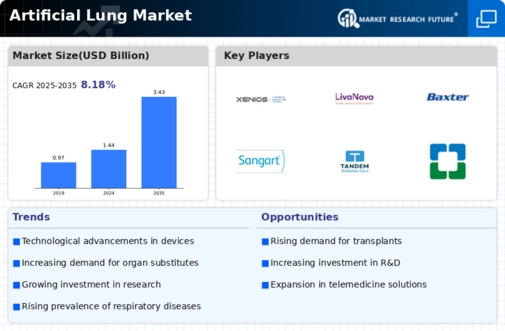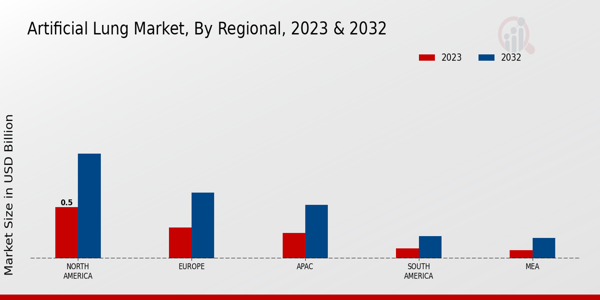Market Growth Projections
The Global Artificial Lung Market Industry is projected to experience substantial growth over the next decade. With a market value of 1.44 USD Billion in 2024, it is anticipated to reach 3.43 USD Billion by 2035, reflecting a compound annual growth rate of 8.21% from 2025 to 2035. This growth trajectory indicates a robust demand for artificial lungs driven by various factors, including technological advancements, increasing prevalence of respiratory diseases, and heightened awareness of artificial organ solutions. The market's expansion is likely to create new opportunities for manufacturers and healthcare providers alike.
Rising Prevalence of Respiratory Diseases
The increasing incidence of respiratory diseases globally is a primary driver for the Global Artificial Lung Market Industry. Conditions such as chronic obstructive pulmonary disease and pulmonary fibrosis are becoming more prevalent, necessitating advanced treatment options. As healthcare systems strive to manage these diseases effectively, artificial lungs present a viable solution. The market is projected to reach 1.44 USD Billion in 2024, reflecting the urgent need for innovative respiratory support technologies. This trend is likely to continue, as the World Health Organization indicates that respiratory diseases are among the leading causes of morbidity and mortality worldwide.
Technological Advancements in Medical Devices
Technological innovations in medical devices are significantly influencing the Global Artificial Lung Market Industry. Developments in biocompatible materials, miniaturization, and automation are enhancing the functionality and efficiency of artificial lungs. These advancements not only improve patient outcomes but also expand the range of applications for artificial lungs in various clinical settings. As a result, the market is expected to grow at a compound annual growth rate of 8.21% from 2025 to 2035, potentially reaching 3.43 USD Billion by 2035. This growth underscores the importance of continuous research and development in the field of respiratory support.
Increasing Investment in Healthcare Infrastructure
The surge in healthcare infrastructure investment globally is a crucial driver for the Global Artificial Lung Market Industry. Governments and private entities are increasingly allocating funds to enhance healthcare facilities, particularly in developing regions. This investment aims to improve access to advanced medical technologies, including artificial lungs. As healthcare systems evolve, the demand for innovative respiratory solutions is likely to rise, further propelling market growth. The anticipated expansion of healthcare infrastructure is expected to create a conducive environment for the adoption of artificial lungs, thereby contributing to the overall market dynamics.
Regulatory Support and Standardization Initiatives
Regulatory support and standardization initiatives play a pivotal role in shaping the Global Artificial Lung Market Industry. Governments and health authorities are increasingly recognizing the need for clear guidelines and regulations governing the use of artificial lungs. This regulatory framework not only ensures patient safety but also encourages innovation and investment in the sector. As regulatory bodies establish standards for the development and deployment of artificial lungs, manufacturers are likely to benefit from a more predictable market environment. This support is expected to facilitate market expansion and enhance the overall credibility of artificial lung technologies.
Growing Awareness and Acceptance of Artificial Organs
There is a notable increase in awareness and acceptance of artificial organs among patients and healthcare providers, which is positively impacting the Global Artificial Lung Market Industry. Educational initiatives and advocacy for organ replacement therapies are fostering a better understanding of the benefits of artificial lungs. This shift in perception is likely to lead to higher adoption rates, as patients become more willing to consider artificial lungs as viable treatment options. Consequently, the market is poised for growth, as acceptance translates into increased demand for these life-saving technologies.










